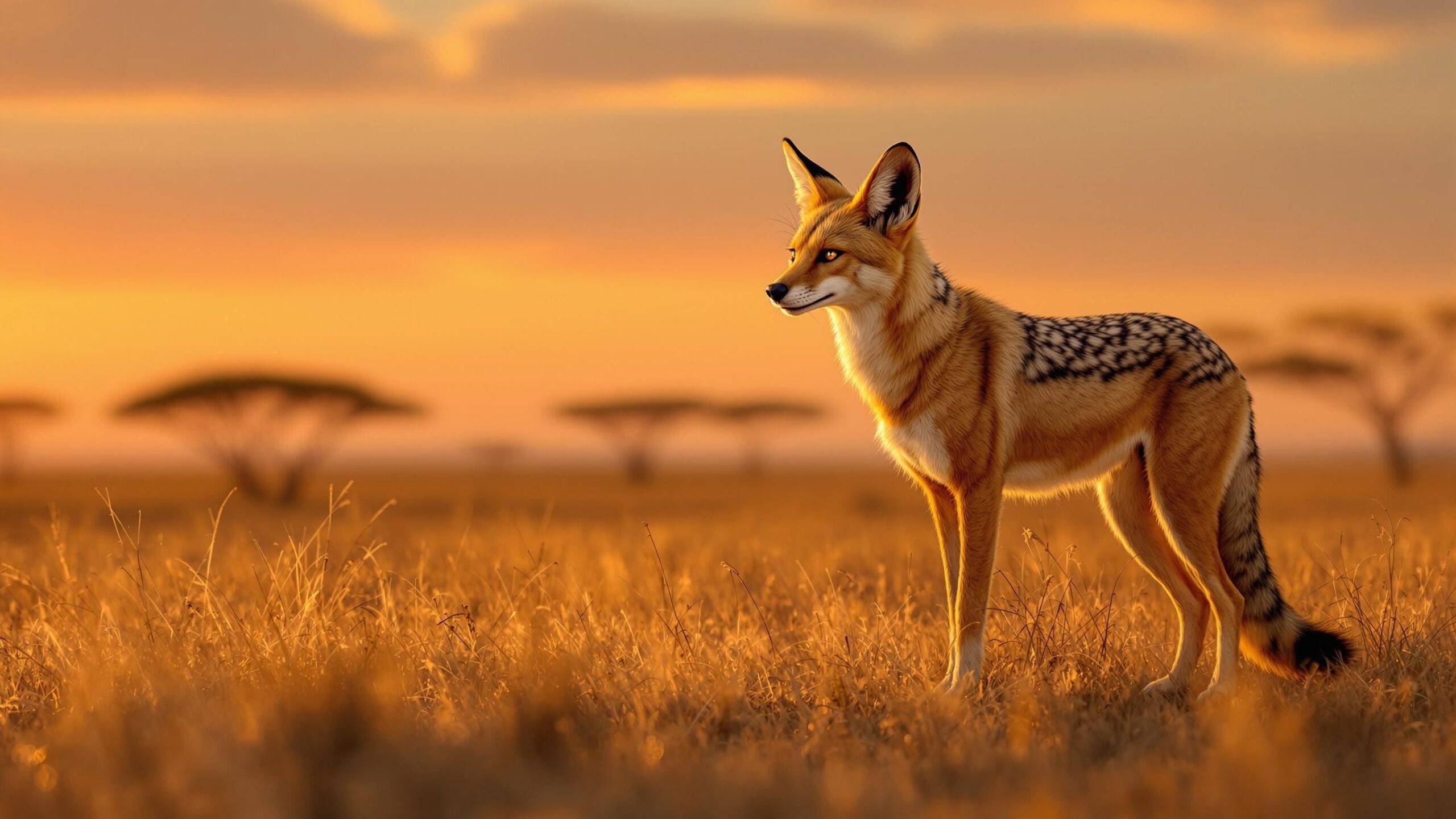Golden Jackal: The Opportunistic Nomad of the Old World
Among the tangled reeds of wetlands, across parched savannas, and through the tangled brush of temperate woodlands roams one of the world’s most resourceful and adaptable canids—the Golden Jackal (Canis aureus). From the sun-drenched landscapes of North Africa to the snow-brushed forests of Eastern Europe and the bustling margins of South Asia, the Golden Jackal has carved out a reputation as a cunning scavenger, agile predator, and social survivor. Despite its modest size, this elusive creature is a powerful ecological player whose influence stretches far and wide.
The Golden Jackal, sometimes referred to as the common jackal, is a medium-sized member of the dog family with a global story written in resilience. Its ability to thrive in a dizzying array of habitats—often alongside humans—makes it one of the most successful canids on Earth. Yet for all its ubiquity, it remains shrouded in mystery and myth, commanding fascination from biologists, conservationists, and storytellers alike.
A Canid with a Golden Hue
The Golden Jackal earns its name from the coloration of its coat, which typically ranges from a rich golden yellow to tawny beige, often flecked with black or gray guard hairs that create a grizzled appearance. Seasonal variations affect coat thickness and color, with winter coats often appearing heavier and slightly paler. Its build is lean and agile, with long legs, a pointed snout, and upright, triangular ears that give it a distinctly alert appearance.
Adult jackals usually measure between 70 to 105 centimeters in body length, with an additional 20 to 30 centimeters in tail length. They typically weigh between 15 to 33 pounds, with males tending to be slightly larger than females. Their movements are graceful and surefooted, combining stealth and speed to outmaneuver prey and competitors alike. Unlike their cousins—the more robust gray wolves or more diminutive foxes—Golden Jackals fall somewhere in between, both in size and in their ecological niche. Their highly adaptable physiology supports a life of versatility and independence.
An Expansive and Expanding Range
Few carnivores can boast a native range as wide or varied as the Golden Jackal’s. Its distribution stretches across Northern and Sub-Saharan Africa, Southeastern Europe, the Middle East, the Indian subcontinent, and even parts of Southeast Asia. Recently, populations have expanded northward and westward into areas of Central and Eastern Europe, including Germany, Austria, and the Baltics—regions it had not historically occupied.
This expansion has been driven largely by changes in land use, climate shifts, and the decline of larger apex predators like wolves. Unlike species that are locked into narrow ecological requirements, the Golden Jackal thrives on change. It is at home in coastal mangroves, rural farmlands, mountain foothills, grasslands, urban fringes, and dry deciduous forests. Its ability to persist in degraded or human-altered environments is particularly striking. In many parts of India and the Balkans, Golden Jackals are regular features of rural life—scavenging at village outskirts, foraging for rodents in farmlands, or slipping through roadside thickets in the dusk.
Diet and Hunting Behavior
Golden Jackals are the embodiment of opportunism in the animal world. As omnivores, they consume a broad spectrum of foods, adjusting their diet based on availability, location, and season. Their prey ranges from small mammals like rodents and hares to birds, reptiles, amphibians, and fish. In some areas, they are known to consume insects in large quantities, especially during dry periods. Carrion is a staple for many Golden Jackals, particularly in areas where they coexist with humans or larger carnivores. They will readily scavenge from the kills of leopards, tigers, wolves, or even domestic dogs. At the same time, jackals are capable hunters in their own right. They often hunt alone or in pairs, using keen senses of hearing and smell to locate prey.
Fruits, berries, roots, and grains also supplement their diet. In agricultural areas, jackals may feed on crops such as sugarcane or peanuts, which can bring them into conflict with farmers. In coastal or wetland regions, fish, crabs, and even mollusks can form a key part of their intake. Their feeding habits contribute significantly to ecosystem balance. As scavengers, they help dispose of carcasses and reduce the spread of disease, while as predators, they keep small vertebrate populations in check.

Social Lives: Family, Territory, and Communication
Golden Jackals are highly social animals that form monogamous pairs and often live in small family groups consisting of a mated pair and their offspring. These family units typically defend a territory, the size of which can vary dramatically depending on resource availability. In prey-rich environments, territories can be small and tightly defended. In more marginal areas, they may range more widely. Pairs cooperate in rearing pups, patrolling territory, and foraging. Older offspring from previous litters may also remain with the group to help raise younger siblings, creating a cooperative family dynamic that increases the odds of survival for new litters.
Communication among Golden Jackals is diverse and intricate. They use a variety of vocalizations, including barks, howls, yelps, and whines, to signal danger, locate each other, or mark territorial boundaries. Their distinctive, wavering howls—sometimes mistaken for wolves or stray dogs—can be heard echoing through forests and fields at twilight. Scent marking with urine and feces is another critical aspect of jackal communication. It helps delineate territory and avoid conflict with neighboring groups. Physical gestures, such as tail wagging, submissive postures, and facial expressions, are also important within the social unit.
Reproduction and Life Cycle
The breeding season for Golden Jackals varies by region but generally peaks in winter or early spring. Courtship begins with increased vocalization and mutual grooming. After mating, the female undergoes a gestation period of about 63 days. She gives birth to a litter typically ranging from 2 to 6 pups, although larger litters are not uncommon in food-abundant regions. Dens may be dug or repurposed from abandoned burrows and are usually hidden in dense vegetation, under rocks, or near water sources.
The female nurses the pups for several weeks, and during this period, the male plays a vital role by guarding the den and bringing food. As the pups grow, both parents regurgitate food to feed them before they transition to solid prey. By about six months of age, the pups begin learning to hunt and may accompany adults on foraging trips. Some juveniles disperse in their first year, while others may remain for an additional season to assist in rearing the next litter. Jackals typically reach sexual maturity at around 11 to 12 months of age, and in the wild, they may live up to 8 to 10 years, although many fall prey to disease, predation, or human-related hazards earlier.
Mythology, Folklore, and Cultural Presence
The Golden Jackal has a deep-rooted presence in the mythology and folklore of many cultures. In ancient Egypt, it was associated with Anubis, the jackal-headed god of the afterlife, who guided souls into the underworld. This symbolic link likely emerged from the jackal’s tendency to roam cemeteries and scavenge from graves—behavior that was both feared and revered. In Indian mythology, jackals often appear as cunning tricksters in fables and parables, outwitting larger animals through wit and guile. The Panchatantra, a classic Sanskrit collection of moral tales, features jackals prominently as clever but sometimes unscrupulous characters. Throughout Southeast Europe, jackals are seen with a mixture of suspicion and admiration. Farmers often regard them as nuisances, but their presence is also accepted as part of the natural rhythm of rural life. In literature and storytelling, jackals symbolize adaptability, survival, and mischief.
Interactions with Humans
Despite their wide distribution, Golden Jackals have a mixed relationship with humans. In many rural communities, they are both familiar and feared. Livestock predation, crop raiding, and scavenging of garbage can lead to conflict, and jackals are sometimes poisoned or shot in retaliation.
Yet, in other areas, they are respected as beneficial scavengers and tolerated for their role in rodent and pest control. Their omnivorous diet allows them to consume agricultural waste, fallen fruit, and even human food scraps—contributing to waste breakdown and nutrient cycling. In urban environments, jackals are becoming increasingly common. Cities like Delhi, Nairobi, and Belgrade have all reported jackal sightings within city limits. These urban jackals tend to be highly nocturnal, avoiding human activity during the day and emerging to scavenge at night. Their presence highlights the adaptability of wildlife in an increasingly human-dominated world.
Conservation and Management
The Golden Jackal is currently listed as a species of Least Concern by the International Union for Conservation of Nature (IUCN), owing to its broad distribution and large, stable population. However, this status does not mean it is free from threats. Habitat fragmentation, road mortality, disease transmission from domestic dogs, and persecution by humans continue to pose risks. In some countries, the expansion of jackals into new territories has sparked debate about their ecological impact. For instance, in parts of Europe, their presence is viewed with concern due to potential competition with native species or changes in predator-prey dynamics.
Some conservationists argue that their spread should be monitored, while others emphasize their ecological role in controlling pests and scavenging carcasses. Effective coexistence strategies may include community education, livestock protection measures, and habitat preservation that allows jackals to fulfill their niche without coming into direct conflict with people. As apex predators diminish in many ecosystems, the jackal’s role becomes even more vital. It occupies a crucial mid-tier role, cleaning up carrion and balancing prey species populations. Recognizing and preserving this role is essential for long-term ecological health.

A Species on the Move
One of the most fascinating aspects of the Golden Jackal is its geographic expansion into new and unexpected regions. Over the past few decades, jackals have made their way into countries like Poland, Hungary, Czechia, and even parts of Germany. This northward spread has baffled researchers and sparked public debate.
Factors contributing to this phenomenon include milder winters due to climate change, declining wolf populations in some areas, and increased availability of anthropogenic food sources. Jackals take advantage of these openings, moving in to establish breeding populations in new niches.This expansion is a textbook case of ecological opportunism and has made the Golden Jackal a species of increasing interest to wildlife biologists and conservation planners. Understanding how they adapt and affect local ecosystems is a vital part of contemporary wildlife science.
The Future of the Golden Jackal
As global ecosystems continue to change—shaped by human development, climate shifts, and biodiversity loss—the Golden Jackal will likely remain a significant player. Its success story is a reminder of nature’s adaptability and the complex ways in which species interact with one another and with people. But with success comes responsibility. As jackals move into new regions, questions of management, conservation, and coexistence become more pressing. Will they disrupt native wildlife? Will they compete with threatened carnivores? Or will they settle into a new role, helping maintain ecological balance where other species have faltered? One thing is certain: the Golden Jackal will continue to roam—howling through moonlit forests, trotting across farmlands, and slipping silently through the margins of our cities. It is a creature of edges and intersections, of ancient myth and modern adaptation. And in a world full of challenges, its story offers a rare note of wild resilience.

